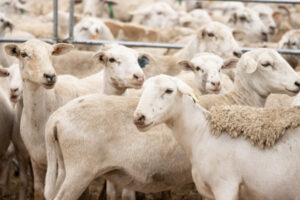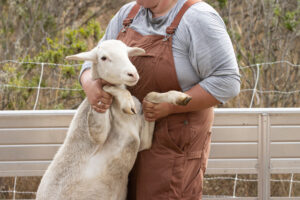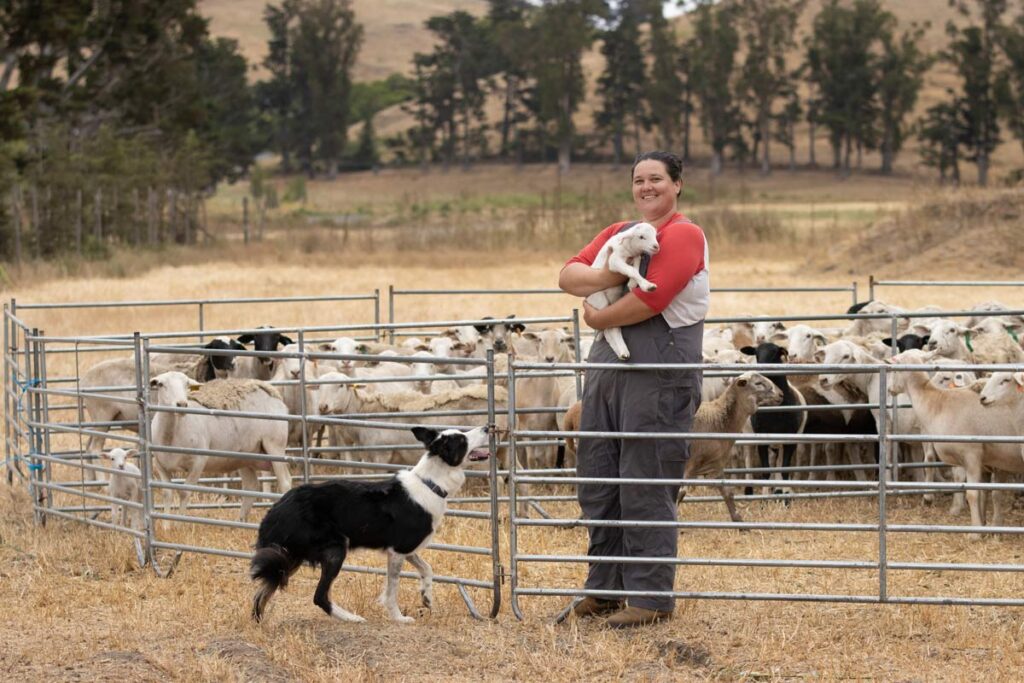Meet Jenna Coughlin: The Indigenous Shepherd Revolutionizing Prescribed Grazing

By Matt Dolkas,
Senior Manager, Marketing
August 11, 2025
“My hope is to demonstrate the validity of prescribed grazing—to show how ecology and agriculture can go together in a really profound way,” says Jenna Coughlin, a Coast Miwok shepherd, as she moves among her flock of sheep at Audubon Canyon Ranch’s Cypress Grove along Tomales Bay. Her enthusiasm and positivity is infectious, a can-do type attitude that makes you want to drop everything, roll up your sleeves, and get to work.
Through her new business Shepherds of the Coast, Coughlin is helping redefine what grazing can accomplish. Her sheep are more than just livestock, they’re precision instruments for land healing, strategically moved to restore native plant communities and reduce the risk of wildfire. Audubon Canyon Ranch is one of many organizations in the conservation movement embracing this approach and supporting entrepreneurs like Coughlin who see agriculture as a path forward in a changing world.
What Is Prescribed Grazing?
Prescribed grazing is a land management technique that uses livestock as tools to restore and maintain healthy landscapes. Unlike traditional grazing, which often focuses solely on the production of food and fiber, prescribed grazing’s success is measured in its impact on the land’s health.
A Growing Demand for Prescribed Grazing
California’s devastating wildfire seasons have turned prescribed grazing from an agricultural curiosity into an urgent necessity. After years of catastrophic blazes that have consumed entire communities and choked the state in smoke, lawmakers finally recognized what shepherds like Coughlin have long known: grazing animals can be some of our most effective firefighters.
In 2024, the state passed landmark legislation that officially includes grazing in wildfire prevention programs and provides critical funding for infrastructure like fencing and water systems. But the law goes deeper than just throwing money at the problem—it acknowledges a hard truth that fire management must make economic sense, because operations like Coughlin’s have to turn a profit to survive and provide these essential land management services.
According to Coughlin, her generation of farmers and ranchers doesn’t have the luxury of choosing between economic viability and environmental stewardship. “We have to do both,” she says. “And maybe that’s exactly what agriculture needs to be.”
Prescribed grazing benefits both the environment and farming operations—strategic timing helps new grass grow better, keeps weeds under control, and builds healthier soil that can support more livestock over longer grazing seasons.
A New Business Model
For all the growing recognition and policy support, the economics of prescribed grazing remain challenging. Coughlin faces the same barriers that keep many young people out of agriculture: the enormous expense of buying land in a region where property values have skyrocketed beyond reach. But rather than seeing this as an insurmountable obstacle, she’s discovered that the very constraints forcing her generation out of traditional agriculture might actually be the key to its reimagination.
Coughlin has partnered with Guido Frosini of True Grass Farms in a collaborative arrangement that benefits both operations. Frosini, whose family has a long history of ranching in Marin County, owns the sheep that Coughlin manages for prescribed grazing projects—sheep that are ultimately raised for meat production. This allows her to focus on the day-to-day management of the flock while he handles the broader aspects of livestock ownership and marketing. It’s the kind of creative partnership that’s becoming essential for next-generation farmers facing the economic realities of West Marin agriculture.
“For me, paying it forward means recognizing the opportunities where I can be of service,” explains Frosini, who has spent over a decade implementing and refining regenerative ranching practices. “And then holding space for those connections and giving them all I can to help them thrive.”



Scaling Up Through Partnership
This past spring, the Marin Agricultural Land Trust (MALT) awarded Coughlin $15,000 to expand her prescribed grazing work—part of MALT’s ongoing small grants program available for all agriculturalists in Marin County. The grant will fund mobile fencing systems, which are crucial for prescribed grazing. These electric fences let shepherds control exactly where animals graze and for how long.
The grant is part of MALT’s larger land stewardship program aimed at building agricultural resilience in Marin County—supporting working farms and ranches that are actively producing food while implementing innovative land management practices. It’s part of a rising tide of support for innovative farming approaches. The organization has long recognized that protecting farmland with agricultural conservation easements is just the first step, and that we must also support the people who actively care for and improve these landscapes.
A Template for the Future
Coughlin’s work represents something larger than just her individual operation—it’s part of a shift toward viewing agriculture as a tool for solving environmental problems. The collaborative business model she and Frosini have developed, supported by organizations like MALT, could become a template for other regions across the West facing similar challenges.
In Marin County, where California’s coastal prairie ecosystem harbors some of North America’s most species-rich grasslands, this work is especially critical. Without the disturbance that well-managed grazing provides, these landscapes would be overtaken by invasive plants or woody shrubs, fundamentally altering the habitats that countless species depend on.
I’ve come to see folks like Coughlin as more than just shepherds, but as land healers. The livestock moving across Marin’s grasslands represent more than a local food system and more than symbols of our region’s agricultural heritage—they’re part of a strategy to create landscapes that can withstand climate change while supporting the rich web of life that calls this region home.
‘I believe we don’t have to choose between making a living and healing the land,’ says Coughlin, whose Coast Miwok ancestors understood this balance long before it became an agricultural innovation. ‘When agriculture works with nature instead of against it, everybody wins—the ecosystem, the community, and the farmers too.'”
Shepherds of the Coast is among five recipients of MALT’s 2025 Building Resilience in Marin’s Working Lands grants round, representing our most recent $200,000 investment in agricultural practices that support both production and environmental goals.